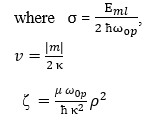Transition Energy For a Polar Quantum Disc with Conical Disclination in Parabolic Confining Electric Potential
Kumar V1, Tshipa M2, Pratap S3*
DOI:10.61343/jcm.v1i02.21
1 Vinod Kumar, Department Of Physics Astronomical Science, Central University Of Himachal Pradesh, HP176206, India.
2 Moletlanyi Tshipa, University Of Botswana Private Bag 0022, Gaborone, Botswana.
3* Surender Pratap, Department Of Physics Astronomical Science, Central University Of Himachal Pradesh 176206, HP, India.
The Transition energy of an electron for a polar quantum disc with conical disclination is investigated theoretically. For charge carrier confinement, we consider the infinite polar square well potential (IPSW), and parabolic potential (PP). The disclination in the system is characterized by the kink parameter κ. The energy levels of the system were calculated using the Schrödinger equation with the effective mass approximation. Our study reveals that the transition energy decreases as the kink parameter κ increases.
Keywords: Transition energy, Conical disclination, Parabolic potentials, Quantum disc.
| Corresponding Author | How to Cite this Article | To Browse |
|---|---|---|
| , , Department Of Physics Astronomical Science, Central University Of Himachal Pradesh 176206, , HP, India. Email: |
Kumar V, Tshipa M, Pratap S, Transition Energy For a Polar Quantum Disc with Conical Disclination in Parabolic Confining Electric Potential. J.Con.Ma. 2023;1(2):147-150. Available From https://jcm.thecmrs.in/index.php/j/article/view/21 |


 ©
© 





 is the quantum mechanical momentum operator with ħ = h/2π, in which h is Planck’s constant, i = √(−1), and ET is the total energy of the electron. For a single electron system in a polar quantum disc with an electric confining potential V(ρ), the wave function can be expressed as:
is the quantum mechanical momentum operator with ħ = h/2π, in which h is Planck’s constant, i = √(−1), and ET is the total energy of the electron. For a single electron system in a polar quantum disc with an electric confining potential V(ρ), the wave function can be expressed as:







 satisfied by the η represented by ηR.
satisfied by the η represented by ηR.
